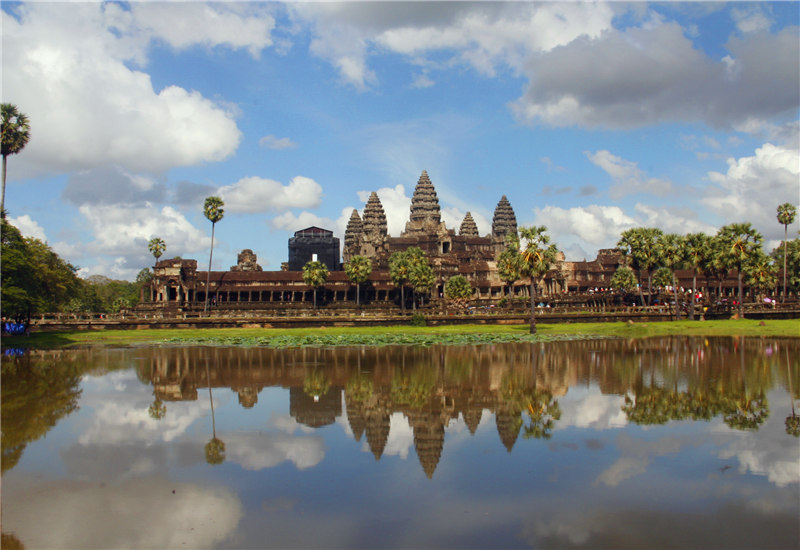Top 10 Facts About Angkor Wat That Will Blow Your Mind
No visit to Cambodia is complete without visiting Angkor Wat. Head deep into the Cambodian jungle to discover the lost city of Angkor - a religious monument said to be the largest one on earth. Giant tree roots strangle many temples, exquisite bas-reliefs tell ancient stories, and massive sandstones lie on the ground. Step back in time with the top 10 mind-blowing facts about this mysterious temple complex hidden deep in the lush jungle.

Angkor Wat Is the Largest Religious Monument on the Planet
Angkor Wat is spread across over 400 acres/1.6 km², and is said to be the largest religious monument in the world. It was listed as a UNESCO World Heritage Site in 1992, which encouraged an international effort to save the complex.
 Angkor Wat
Angkor Wat
Angkor Wat Is Featured on the Cambodian Flag
Since around 1850, Angkor Wat has been featured in the center of the national flag of Cambodia, as if to show their incredible pride in the ancient monument. Their pride is also reflected by putting images from Angkor Wat on many denominations of the riel (Cambodia's currency).
Angkor Wat Means "City of Temples" in Khmer
In Khmer, the Cambodian language, Angkor means "city" or "capital city", and Wat means "temple grounds". So Angkor Wat means "Temple City" or "City of Temples". Its original name was Vrah Vishnuloka or Parama Vishnuloka, meaning the sacred dwelling of Vishnu in Sanskrit.
Angkor Wat Was Shared by Two Religions
It was originally built as a Hindu temple dedicated to the god Vishnu, breaking the previous kings' tradition of worshiping Shaiva. It gradually turned into a Buddhist temple towards the end of the 12th century and is still used for worship today.
Angkor Wat Was Built as A Representation of Mount Meru
Mount Meru, in Hindu Mythology, is the sacred five-peaked mountain standing in the center of the universe. It's said that the three Hindu chief gods - Brahma (the Creator), Vishnu (the Preserver) and Shiva (the Destroyer), and Hindu demi-gods (Devas) reside on the top of this mountain.
Angkor Wat is Typically Related to Death in Hinduism
Unlike most Angkorian temples which are commonly directed to the east, Angkor Wat is oriented to the west, a direction associated with death in Hindu culture. So, many archaeologists and scholars have concluded that Suryavarman intended to use it as a funerary temple.
Also, the direction means it faces the sunset, which adds to its beauty and attracts many visitors at this time.
The Bas-Reliefs at Angkor Wat Read Counterclockwise
which is the reverse of the normal order, and is thought to be another indication that the temple is associated with funeral rituals.
Five Million Tons of Sandstone Were Used to Build Angkor Wat
The sandstone blocks used were quarried from the holy mountain of Phnom Kulen around 50 kilometers/31 miles away from the site. The heaviest block weighs up to 1,500 kilograms / 3300 pounds, so the logistics of moving this sandstone are mind-blowing and must have been extremely labor-consuming. The workers had to get creative, which is why it's thought that the sandstone was transported to the Siem Reap River using canals and then floated down the river on rafts.
The Vast Numbers That Make Up Angkor Wat
According to inscriptions, the construction of Angkor Wat is thought to have taken approximately 30 years, 300,000 laborers and 6,000 elephants. Angkor Wat was initially designed and constructed in the first half of the 12th century, during the reign of Suryavarman II (ruled 1113 – c. 1150), as the king's state temple and capital city. It was built without the aid of any machinery, as there was no machinery available at that time.
The Walls Are Decorated With Thousands of Bas-Reliefs
The bas-reliefs on the walls represent important deities and figures in the Hindu and Buddhist religions and key events in their narrative tradition.
Angkor Wat is a must-see for any Cambodia tour, forming a wonderful picture backdrop that one treasure forever. You will always remember the feeling of wandering the sprawling and carved ruins. You are welcome to contact us for a tailor-made vacation to the intriguing Angkor Wat.
Quick Question
What Our Clients Say
Explore the latest verified reviews of Odynovo's travel services on Tripadvisor, Google, Trustpilot, Product Review and more trusted platforms.
SUBSCRIBE TO WIN A FREE TOUR
Subscribe to our newsletter for a chance to win a free 7-day tour to India! And more insider travel news, exclusive offers, and inspiration will be sent straight to your inbox. Check our previous newsletters and get some sparks.

